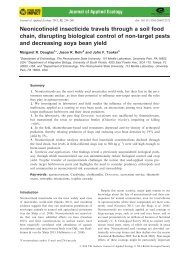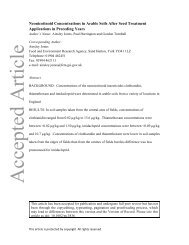g62-encyclopaedia-of-pests-and-natural-enemies-in-field-crops
g62-encyclopaedia-of-pests-and-natural-enemies-in-field-crops
g62-encyclopaedia-of-pests-and-natural-enemies-in-field-crops
- No tags were found...
You also want an ePaper? Increase the reach of your titles
YUMPU automatically turns print PDFs into web optimized ePapers that Google loves.
Pollen beetle (Meligethes spp.)Crops affectedCereals✔ Oilseeds✔ Vegetable brassicasPotatoesCarrotsAlliumsPeasField beansSugar beetLettuceImportanceIn oilseed rape, adult <strong>and</strong> larval feed<strong>in</strong>g can lead tobud abortion <strong>and</strong> reduced pod set. This damage rarelyresults <strong>in</strong> reduced yields for w<strong>in</strong>ter <strong>crops</strong> but spr<strong>in</strong>g<strong>crops</strong> can be more vulnerable as the susceptible green/yellow bud stage <strong>of</strong>ten co<strong>in</strong>cides with beetle migration.Adults are occasional <strong>pests</strong> <strong>of</strong> cauliflower <strong>and</strong>broccoli, feed<strong>in</strong>g on the curds or florets <strong>in</strong> midsummerwhen new adults emerge from oilseed rape<strong>crops</strong> <strong>and</strong> move <strong>in</strong>to other areas to feed.Risk factorsCrops are usually most at risk when the weather isdry <strong>and</strong> warm (above 15°C).The damage-susceptible stage <strong>of</strong> the oilseed rape crop is green to yellow bud.Oilseed rape will usually compensate for early damage by produc<strong>in</strong>g more <strong>and</strong>larger seeds on lower racemes. Backward <strong>crops</strong> <strong>and</strong> those suffer<strong>in</strong>g from pigeondamage are at greater risk.In vegetable brassicas, the risk <strong>of</strong> <strong>in</strong>festation is higher if horticultural <strong>crops</strong> are closeto <strong>field</strong>s <strong>of</strong> oilseed rape.© Dewar Crop Protection© Emily GrahamPollen beetle (Meligethes spp.)Life cycleJan Feb Mar Apr May Jun Jul Aug Sep Oct Nov Dec1 2 134 51 Adults overw<strong>in</strong>ter <strong>in</strong> sheltered spots.2 Adults migrate <strong>in</strong>to oilseed rape <strong>crops</strong> whentemperatures exceed 15°C. They feed on pollen<strong>in</strong>side buds or <strong>in</strong> open flowers.3 Eggs are laid <strong>in</strong> buds.4 Larvae feed on pollen before pupat<strong>in</strong>g.5 Adults emerge <strong>and</strong> feed on a variety <strong>of</strong> plants.Once the crop starts flower<strong>in</strong>g, the beetles move tothe open flowers, becom<strong>in</strong>g poll<strong>in</strong>ators rather than<strong>pests</strong>.Identification <strong>and</strong> symptomsThe adults are small (approx. 2.5 mm), metallicgreenish-black <strong>and</strong> have clubbed antennae.Females bite slits <strong>in</strong> the base <strong>of</strong> oilseed rape buds <strong>and</strong>lay their eggs <strong>in</strong>side.The larvae are creamy white, with a black head, threepairs <strong>of</strong> legs <strong>and</strong> dark brown spots <strong>and</strong> short bristlesalong the back. They grow to 3–4 mm long.Adults <strong>and</strong> larvae attack buds <strong>and</strong> flowers, result<strong>in</strong>g <strong>in</strong>withered buds <strong>and</strong> reduced pod set.© Dewar Crop ProtectionPollen beetles on oilseed rapePollen beetles on oilseed rapeBl<strong>in</strong>d stalks on oilseedrape due to pollenbeetle damage27Pests: BeetlesPests: Beetles28




